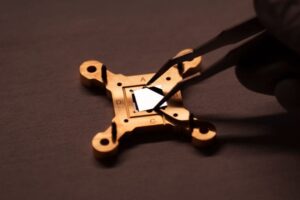 Pin
Pin Image from Freepik
For the first time in human history, a single particle was successfully quantum teleported into space. The term quantum teleportation may sound like it belongs in science fiction, but it’s very real — and it’s unfolding now. This breakthrough didn’t happen overnight. It took years of global collaboration, tireless experiments, and hope that something once thought impossible might just work.
On the surface, it’s just one particle. One tiny, unseeable thing. But for quantum physicists, this is like landing on the Moon for the first time. It’s more than science. It’s a shift in how we understand the universe.
This wasn’t about moving the particle through the air. It was destroyed on Earth and perfectly reformed in space, preserving every bit of its quantum state. It’s not magic, it’s quantum entanglement at work.
This marks the beginning of something much bigger.
Table of Contents
How the Experiment Was Done — China’s Micius Satellite
This wasn’t a science fiction scene from a futuristic film. In 2017, a team of Chinese scientists used a satellite named Micius to perform quantum teleportation. The team, led by Jian-Wei Pan, managed to send quantum information from a photon on Earth to its twin 500 kilometers above in orbit. It was done using entangled photons — particles linked in such a way that the state of one instantly affects the other, no matter the distance.
Here’s what made the experiment remarkable: the team entangled two photons on Earth, then beamed one of them to the satellite using a laser and ground-based telescope. The information in the quantum state was then measured and recreated aboard the satellite. The photon itself didn’t travel — just its state did. That’s what makes it “teleportation.”
The precision and technology behind this were cutting-edge: vacuum tubes, high-powered lasers, and ground-satellite synchronization — all done with near-zero error margin. The implications of this success are hard to exaggerate.
What Quantum Teleportation Actually Means
When people hear “teleportation,” they think of Star Trek transporters. But in the real world of quantum physics, it means something entirely different. Quantum teleportation doesn’t involve moving matter from one place to another. Instead, it’s about transferring the state of a particle — its full quantum information — to another particle that could be far away.
This happens through a bizarre but proven concept called quantum entanglement. Two entangled particles share such a strong connection that when you measure one, you instantly know everything about the other. Even if they’re hundreds of kilometers apart, the state of one defines the other. That’s the loophole that allows teleportation.
So in the 2017 experiment, the photon on Earth was measured, and that action immediately changed the photon in space — recreating the original’s quantum state up there. It’s like perfectly copying your mind into another body on Mars — while your body stays behind and gets erased. It’s weird. It’s real. And it changes everything.
Why This Matters More Than Sci-Fi Dreams
This breakthrough isn’t about building teleporters for humans — at least, not yet. But it has serious, practical implications for the world we live in. Quantum teleportation is the foundation of quantum communication, which could lead to unhackable networks, faster-than-light data syncing (theoretically), and revolutionary computing systems.
Think about global cybersecurity. Right now, our encrypted systems depend on complex math, which quantum computers could break. But quantum communication, powered by teleportation, can’t be intercepted without detection. Any disturbance in the entangled state is noticeable — meaning spies can’t snoop unnoticed. It’s like setting up a phone call where the moment someone listens in, the line goes dead.
This isn’t just future theory. Governments and tech giants are investing billions in quantum communication networks. China’s experiment was a flex — showing it could build satellite-based quantum internet. The U.S., Europe, and others are now racing to catch up. It’s not about moving particles across space. It’s about moving into a new era of information.
The Role of Entanglement – Spooky, But Real
Albert Einstein once called quantum entanglement “spooky action at a distance,” because it defied everything classical physics stood for. How could two particles, separated by space, respond to each other instantly — without any signal in between? Decades later, experiments have shown again and again: entanglement is real. And it’s the backbone of quantum teleportation.
In the 2017 experiment with the Micius satellite, entanglement made it possible to transfer the quantum state of a photon from Earth to orbit. It wasn’t magic. It was physics — weird, counterintuitive, but experimentally verified.
Entanglement is like two dancers, perfectly mirroring each other no matter how far apart they are. The twist? You don’t know the dance moves until you watch one of them — and instantly, the other one does the same thing. It’s not sending data through space; it’s about creating a shared state that space can’t break.
Without entanglement, teleportation wouldn’t exist. This isn’t a theory anymore. It’s now part of real-world physics, tested in labs — and in orbit.
Challenges Faced During the Space Experiment
Quantum teleportation isn’t easy. Doing it on Earth is already a challenge. Doing it across hundreds of kilometers into space? That’s a different beast. The Micius satellite experiment pushed the limits of physics, engineering, and timing.
First, photons are delicate. They can be lost easily while traveling through Earth’s atmosphere or get scattered by clouds and particles. The team had to wait for perfect weather and atmospheric conditions to even begin. Even then, only a tiny fraction of photons sent from Earth ever made it to the satellite — less than one in a million.
Second, precision was everything. The laser beam that carried the photon’s state had to be aimed with mind-blowing accuracy at a moving satellite. One small vibration could throw it off. Scientists used adaptive optics and powerful telescopes just to keep the beam steady.
Lastly, the timing had to be exact to detect and record entanglement across such a distance. Every detail had to line up. This wasn’t luck. It was years of planning, testing, and execution.
Implications for the Future of Quantum Communication
This successful quantum teleportation to space wasn’t just for show — it’s laying the foundation for an entirely new kind of internet. A quantum internet that could connect cities, countries, even continents, with security so tight it would make today’s encryption look like child’s play.
With this technology, data won’t be transferred using electrical signals or radio waves. Instead, it’ll be shared through quantum states using entanglement. The key benefit? It’s nearly impossible to hack. If anyone tries to tap into a quantum connection, the system instantly detects the intrusion.
China’s Micius satellite was the first proof-of-concept. It demonstrated that quantum communication isn’t limited by fiber optics. With enough satellites, we could build a global quantum network — one that links data centers, governments, and research labs with zero fear of interception.
Right now, countries are racing to get there first. What used to be a scientific curiosity is now a new kind of arms race. Whoever builds quantum internet first could control the future of global communication.
Are Human Transporters Next? Let’s Get Real
With the word “teleportation” in the headlines, it’s natural to think about Star Trek-style transporters. But let’s not get ahead of ourselves. Quantum teleportation doesn’t move matter — it transfers information. That’s a big difference. Scientists didn’t send a physical photon into space — they recreated its quantum state on another photon that was already there.
To teleport a human being, you’d need to scan and break down every atom in the body — all 7 octillion of them — and then rebuild that exact state elsewhere. And here’s the catch: quantum teleportation requires destroying the original. So you wouldn’t just be moving. You’d be ending one version of yourself to recreate another. That opens up not just scientific problems, but ethical and philosophical ones too.
So no, we’re not building human transporters anytime soon. But the principles behind teleportation are real, and they’re already changing how we communicate. The dream of instant matter transport might still be science fiction, but teleporting quantum information? That’s already happening.
How the World is Reacting to This Breakthrough
This achievement didn’t just catch the attention of physicists. It sent ripples across governments, tech industries, and defense sectors around the world. After China’s success with the Micius satellite, global powers realized quantum teleportation wasn’t just a theoretical milestone — it was a strategic one.
The United States quickly ramped up its quantum communication programs. The European Union launched initiatives to develop quantum-secure networks across its member states. India, Canada, and Japan also announced significant investments into quantum research. It’s no longer just about exploring the unknown — it’s about staying ahead in a new kind of technological race.
Even private companies are getting involved. IBM, Google, and startups like ID Quantique are betting big on quantum communication systems. This isn’t a distant future. It’s a now-or-never moment to build new infrastructure based on principles we’re only just starting to harness.
The global response proves one thing: quantum teleportation is more than a headline. It’s the front line of the next digital revolution.
What Comes Next – The Road Ahead for Quantum Science
Now that quantum teleportation into space is no longer theory but reality, the next question is: where do we go from here?
Scientists are working to improve fidelity — how perfectly a quantum state can be transferred. Right now, teleportation experiments still have small margins of error, which must be eliminated if we’re going to build real-world applications. Another focus is distance. Can we teleport quantum states from Earth to the Moon? Or even farther?
There’s also talk of expanding the number of particles. So far, it’s usually single photons. But quantum states of atoms, ions, and even small molecules are being explored. That’s a huge leap — and one that could bring us closer to real quantum computers that communicate through teleportation.
Then there’s the real dream: a quantum internet. Fully secure, instant, and global. It’ll take years, maybe decades, but the pieces are falling into place. And it all started with a single photon, beamed into space. The road is long — but it’s open.

































